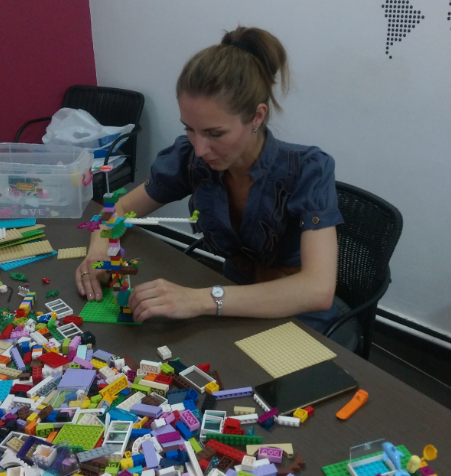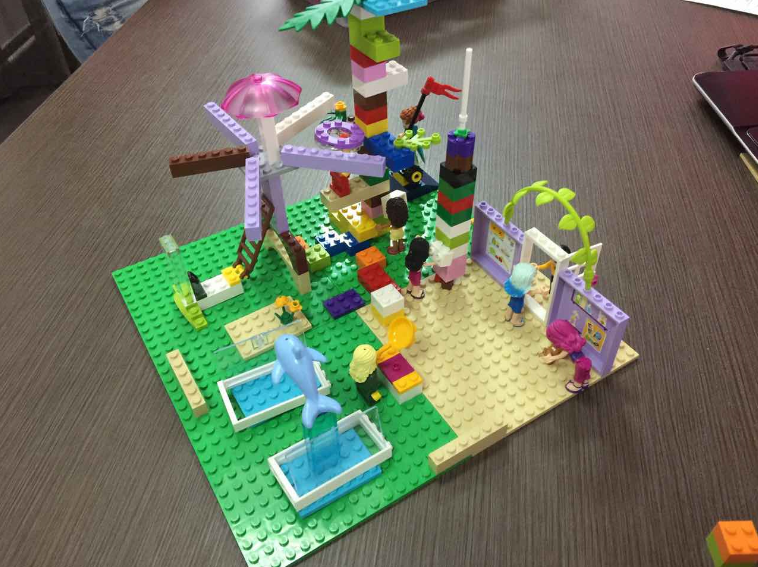Method Lego Serious Play: how to formulate and use the values of the team with the help of children's designer
Long stay in the comfort zone leads to problems
Once, when I was holding cards for planning-poker with 5 SCRUM values, I realized that some of the values in our team are “sagging”. Although in the team we confess them.
- Sometimes we stop hearing the customer, we don’t dive enough into the task and don’t try to solve the customer’s problem on a deep level. This is due to the fact that we have been working for a long time in our area of responsibility. And the focus of our attention is gradually narrowed to the circle of our immediate tasks. We just stop paying attention to the problems of people around.
- Due to the problem indicated by the item above, team members can sometimes afford to give a harsh answer to their colleagues if they cannot understand for a long time. This attitude does not stimulate openness; the next time a person spends a few extra hours better than he turns for help again.
- Long work in the same area of responsibility leads to stereotyped thinking. Sometimes we solve problems on the “knurled” path because of the fear of leaving the comfort zone, of confronting something new and even banal laziness to explore the issue more deeply.
- Individual team members are not sufficiently open to the knowledge of sharingu because of the introversion of character.
As a result, we spend more time on tasks, sometimes there are problems with architecture due to superficial research or the fact that someone did not share knowledge.
The main reason is that we and the team have been together for 3-4 years. On the one hand, this allows us to write code in the same style, build the architecture of the application in the same style, which significantly reduces the time spent on project maintenance. On the other hand, this “obscuration” of a view does not contribute to an open and respectful relationship with customers and with each other. It's time to "shake things up".
What is the meaning of the team invests in the values of SCRUM
- Courage. The courage to make decisions. The courage to take responsibility for the fulfillment of goals. Courage to introduce new technologies. The courage to accept possible mistakes and work on their elimination.
- Focus. During the sprint process, the team focuses on performing certain tasks. It is the focus that allows you to fulfill the goals of the sprint on time.
- Devotion. Team members are committed to the common cause, to each other. And it is precisely dedication that allows you to take obligations and feel responsibility, to do business with enthusiasm and interest.
- Respect. We respect each other and the differences between us. We respect a different opinion, because the pluralism of opinions allows us to find the best solution. It is the differences between us that allow us to build a complementary team. We respect the fact that each member of the team may not know something and are ready to fill the gap in knowledge, because in the end the whole team benefits from this.
- Openness Information inside and outside the team is open. And everyone has access to it. Openness allows time to make adjustments to the actions of the team. We are open to new knowledge and new opinion. We are open to criticism, because thanks to criticism we can become better.
To improve the situation, we decided to hold a regular mitap and collectively recall what unites us. In this case, I used two techniques: the game of self-determination to identify the core values of the team and Lego Serious Play in order to understand how to use them correctly. In my opinion, we managed to solve the tasks, so I recommend the technique for other teams.
We carry out the game of self-determination to identify team values
Sound the main values of SCRUM
Courage, focus, dedication, openness and respect. Tell us what they can give the team.
Select values that are important to your team.
Each person can have their own understanding of the values of SCRUM. Moreover, completely different things may be important for him, which will guide him in his work.
')
Therefore, it is more correct not to impose five values of SCRUM, but to give everyone to choose what is really important. I made a list and offered to choose the most important values that are important for everyone.

As a result, the team formulated a list of 6 values (instead of 5). Each of them is important for the whole team:
- Flexibility.
- Enthusiasm.
- Openness
- Mastery
- Respect.
- A responsibility.
We form an understanding of values with the help of Lego-models
After the game of self-determination, a legitimate question arose: how to use values to work with each other and other teams? To answer it, I suggested using the Lego Serious Play (LSP) technique.
The main advantage of the technique is 100% involvement of each member of the game. LSP is not about having a great time with Lego cubes (although this goes hand in hand with the process).
You come to the game with the main goal - to find a solution to the problem, and the cubes are just a tool, designed to “crack the brain” of your brain activity.
How does LSP stimulate the development of new knowledge? A person is often not aware of what he knows. Our memory and the process of extracting information from it are difficult. Cubes help to stimulate this process and generate new knowledge based on existing experience.
The formula for this "magic" is as follows:
Emotions govern attention> Attention controls learning> Learning controls memory.
The LSP technique involves several steps.
- We set out the rules of the game and the question that needs to be answered.
- We build individual lego-models and stories that clearly show complex and abstract concepts. In our case - team values and their practical application.
- We present models and stories to the team.
- Create a landscape, i.e. we place individual models in a common space.
- Create links between models.
- We build the general integral system.
- We lose non-standard situations and decisions.
- Reflect and extract simple guidelines.
Basic LSP Rules
- All get the same set of Lego cubes.
- The individual model should reflect your personal understanding of the question posed.
- Cubes should be used as a metaphor, and not as a tool for real world display.
- If you don't know what to build, just start building. Trust your hands.
- The individual model belongs to the person who built it; no one can move the parts without the owner’s consent. Make sure the changes do not change the meaning of the model.
- Discuss the model, not the person who built it.
Use magic on mitap
On our mitap, I decided to retreat from the first rule and not limit the toolkit. She poured a box of Lego cubes and additional figures on the table. Again I put the question to the participants of the meeting: “How to use the selected values in our work?”
The construction of models from four participants took about 15 minutes. Then each presented his model and answered the questions of his colleagues: what does this or that part mean? What is the meaning of it? Why are the parts arranged so and not otherwise?

These discussions helped to understand the meaning that each of us invests in team values, as he sees their use within the team. And the manager was able to understand more deeply how each participant lives, what problems he cares about, which prevents him from moving further.
Then the very magic of LSP began - the unification of individual models into one common with analysis and the establishment of links. At first it was difficult for us to turn individual models into one system. The discussion and analysis of each element of the models helped a lot. We managed to understand which elements are important for the authors, and which can be easily removed.
The key value of the process is that each participant was able to “rise” above his individual model and see the big picture: how his model becomes part of the system, what it influences, how the system transforms depending on its constituent elements. As a result, an understanding emerged in the head of each team member how his value system affects everyone else. At the same time, everything happened in a relaxed atmosphere of a game with a designer, from which all participants got a lot of pleasure.

By the same principle, you can discuss the "anti-value" of your team. This will help to understand which behavioral patterns are not acceptable and why. In a normal conversation on this topic, it is easy to touch the interlocutor and not solve the problem, and the LSP technique helps to make it more sensitive and efficient. The participants of the game abstract away the personality of their colleagues and discuss models from Lego cubes. As a result, everyone gets the opportunity to look at the problem from the outside and understand another's point of view.
Source: https://habr.com/ru/post/343180/
All Articles